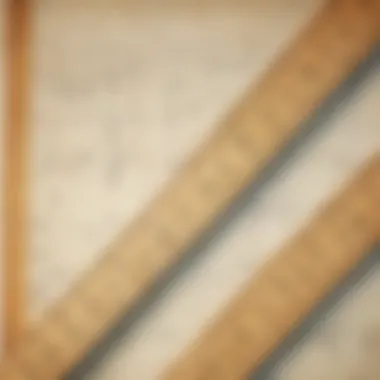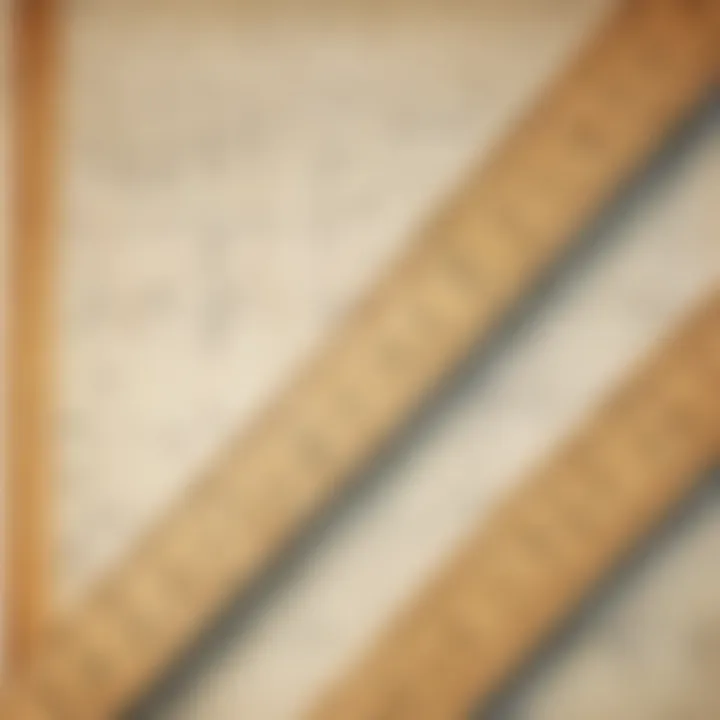Innovative Measuring Techniques: Beyond the Tape


Intro
Measuring accurately can be a challenge without the usual tape measure. However, there are various creative techniques to achieve precise measurements without relying on conventional tools. This article explores these methods and demonstrates how household items and mathematical approaches can serve as effective substitutes. Understanding these techniques not only enhances problem-solving skills but also fosters a resourceful mindset, especially useful for parents and caregivers engaging with children.
Creative Activities
Engaging children in creative activities is an excellent way to teach measurement concepts. By incorporating measurement tasks into fun projects, children can learn while being hands-on and actively involved.
Craft Ideas
Children can create various crafts that require measuring, even without a measuring tape. Here are some ideas:
- String Art: Use pieces of string to outline shapes. Measure lengths by using the child's own hand span or foot size.
- Homemade Clay Models: Make models out of clay that involve measuring shapes and dimensions, like building a small house.
- Paper Planes: Have children fold their own planes and measure wingspans using simple math.
Step-by-Step Guides
- String Art:
- Homemade Clay Models:
- Paper Planes:
- Gather colorful strings and a cardboard base.
- Decide on shapes or designs to create.
- Use hand lengths to measure the strings needed.
- Cut the strings and tie them to the base to form patterns.
- Provide clay for modeling.
- Ask children to create their own models and assign measurements based on their hands or arbitrary units like a shoe size.
- Compare the sizes of each child’s model to see differences.
- Use a standard sheet of paper to demonstrate folds.
- Have children make their own adjustments for wing size.
- Measure the distance the planes can fly using foot movements.
Educational Value
These activities support learning by allowing children to measure using non-traditional methods. This hands-on engagement reinforces understanding of measurements and encourages problem-solving skills. Children also develop creativity while learning practical skills.
The End
Exploring measurement techniques beyond the standard tape measure provides valuable opportunities for learning and creativity. Whether through crafts or practical applications, these methods promote a sense of achievement and resourcefulness. By encouraging children to engage in these activities, parents and caregivers help build not only knowledge but also confidence in their measuring abilities.
Understanding the Need to Measure
Measuring accurately is a fundamental skill that has diverse applications in everyday life. Understanding the need to measure is essential, as it lays the foundation for many activities, whether in home improvement, crafting, or education. This importance is especially relevant when conventional measuring tools, such as tape measures, are not available. It calls for resourcefulness and creative thinking. In a world that often prioritizes precision, learning how to measure without traditional tools can enhance our problem-solving abilities.
Situations Where a Measuring Tape is Unavailable
There are various scenarios in which a measuring tape might not be readily accessible. For instance, during a spontaneous DIY project at home, one may not have a tape measure on hand. Packing for a trip can also present challenges; when determining if belongings fit within the luggage, a tape measure might be absent. Likewise, educators may find themselves in a classroom setting with students needing to measure dimensions of projects without conventional tools.
In such instances, understanding alternative methods becomes crucial. In an age where we often rely on digital gadgets, the reliance on physical measuring tools is sometimes overlooked. Being equipped with knowledge about how to measure in diverse environments fosters independence and encourages innovative thinking.
Importance of Accurate Measurements
Accurate measurements are vital across various activities. Whether measuring materials for a home renovation or ensuring the correct size for a craft project, precision impacts the overall outcome. Poor measurements can lead to wasted resources, increased costs, and time spent rectifying mistakes. Thus, cultivating the ability to measure accurately, even without traditional tools, becomes a significant advantage.
Furthermore, accurate measurements are essential in educational settings. They aid in developing mathematical skills and critical thinking among students. Observing the physical world enables learners to grasp abstract concepts in measurements and geometry more effectively.
"Accurate measurement is the key to making informed decisions in crafts, repairs, and education."
Utilizing Everyday Items
In the quest for accurate measurements without a tape measure, utilizing everyday items proves essential. These common objects not only offer immediate alternatives but also reflect a resourceful mindset that is often necessary in various situations. Knowing how to adapt familiar items into tools for measurement can significantly enhance your ability to complete tasks efficiently. Moreover, this practice promotes sustainability, as it encourages the reuse of materials that might otherwise be discarded.
Common Objects as Measuring Tools
Paper and Cardboard
Paper and cardboard serve as versatile measuring tools in many scenarios. Their rigidity and flatness make them suitable for marking or measuring space. For instance, a standard sheet of A4 paper has dimensions of 21 x 29.7 centimeters, which can be useful for making quick comparisons or layouts.


One unique feature of paper is that it can be folded to create specific measurements. You can fold a paper into halves or quarters, allowing for incremental measurements. This characteristic lends paper the advantage of being both lightweight and portable. However, the major disadvantage is its vulnerability to damage. Wet conditions or excessive handling can render paper less reliable in accuracy.
String and Twine
String and twine can easily be used to measure distances across uneven surfaces. This choice is beneficial because of the flexibility they offer. A length of string can be stretched from one point to another, accommodating various shapes and dimensions.
A significant attribute of string is that it can be marked or cut to signify specific lengths. This is especially advantageous in DIY projects where exact measurements are necessary. However, the drawback is that string tends to sag when not taut, which can affect precision.
Rulers and Yardsticks
Rulers and yardsticks provide an excellent option for measuring lengths accurately. Their typical length of 30 centimeters or 1 yard means they can easily be used for various projects. Rulers often include both metric and imperial measurements, creating versatility.
A notable advantage of using rulers and yardsticks is that they are explicitly designed for measurement, and provide a clear reading. This clear demarcation allows for easy comparison between different lengths. On the downside, their fixed length can make them limiting for larger projects, as they may need to be repositioned frequently.
Using Fingers and Body Parts for Measurement
When standard tools are not available, fingers and body parts can be surprisingly effective for estimation. This method reflects a natural approach to measurement that does not rely on external instruments.
Fingerbreadths and Hand Spans
Fingerbreadths and hand spans are defined by the individual's tactile dimensions. Using your own fingers as a measurement tool is convenient since it requires no additional resources. It essentially turns one's body into a ruler. The hands are often different in size, but on average, a fingerbreadth is about 1.5 centimeters.
This method is popular for making quick assessments without the need for tools. However, a disadvantage is that personal variance can lead to discrepancies in measurement accuracy. Each individual’s fingerbreadth varies, so accuracy may not be consistent across different users.
Feet and Arm Lengths
Using feet and arm lengths as measurements showcases how one can leverage their own physical attributes. On average, a human foot measures about 30 centimeters, while an arm span can provide distance measurements equivalent to that of one’s height.
This approach offers practicality and eases the act of measuring large areas, as one does not need to fuss with physical tools. However, similar to finger measurements, the variance in size among individuals can present practical limitations. Some may find it difficult to replicate the exact measurements due to differences in body size.
Leveraging everyday items for measurement can significantly enhance creativity and problem-solving abilities in various tasks.
Mathematical Methods for Estimation
Mathematical methods serve as a solid foundation for estimating measurements without traditional tools. These techniques are not just about numbers; they enhance our ability to judge size, area, and proportions with a degree of accuracy that is often sufficient for practical applications. In situations where a measuring tape is not available, understanding these methods can lead to effective solutions. The primary benefit lies in their accessibility. Most people can apply basic mathematical concepts with little training, often using items around their homes. This article focuses on two specific methods that enhance measuring efficiency: geometry for area calculation and proportional sizing techniques. Both methods emphasize the important relationship between physical dimensions and mathematical principles, making them invaluable skills for various tasks.
Using Geometry for Area Calculation
Geometry provides tools for calculating areas without requiring direct measurements. Understanding fundamental shapes and their properties enables estimations based on known dimensions or references. For example, if one needs to estimate the area of a rectangular garden but lacks a tape measure, they can rely on geometry by using a known object. First, find the dimensions of the known object—let’s say a standard sheet of paper, which is typically 8.5 inches by 11 inches.
By laying the sheet of paper alongside the garden, a person can estimate the number of sheets that fit within the area.
Here’s how that works:
- Measure the area of the known object: Determine its area by multiplying length times width. In this case, 8.5 inches x 11 inches equals 93.5 square inches.
- Estimate coverage with the known object: Count how many sheets fit within the boundaries of the garden.
- Calculate the estimated area of the garden: Multiply the number of sheets by the area of one sheet. For instance, if five sheets fit, then 5 x 93.5 square inches equals 467.5 square inches for the garden area.
Using this geometric approach ensures a practical understanding of how areas relate to one another, providing a reasonable estimate quickly without precise measuring tools.
Proportional Sizing Techniques
Proportional sizing is another effective mathematical method. It relies on the concept of ratios and comparing dimensions to achieve accurate estimations. Here, one can use everyday objects to create proportional measurements. For instance, if measuring the height of a fence is impossible without a tape, a person can use their own height as a reference to derive the fence’s height.
To perform this:
- Identify your own height: Let’s say a person is 5 feet tall.
- Estimate the fence’s height visually: Stand close and visually compare. If the fence appears to be two times taller than the individual standing next to it, then the estimate would be 10 feet tall.
- Record the estimated measurement: This can serve whatever project is underway, knowing it's a visual guess but based on proportional logic.
Proportional sizing can also extend beyond height. It can apply to lengths, widths, and other measurements. This technique allows flexibility, as it can be adapted to numerous situations by referencing anything from a pencil to a classic car.
Accurate estimations rely on understanding the relationships between objects, not just the objects themselves.
By developing these mathematical methods, individuals can confidently estimate sizes and areas without needing extensive tools or technical expertise. In essence, mathematical techniques simplify the measuring process, proving essential in various scenarios, whether for DIY projects at home or educational exercises.


Techniques for Measuring Distance
Measuring distance without a conventional tape measure can be essential in many situations. The ability to accurately estimate distance can influence various activities, from home projects to outdoor adventures. This section outlines useful techniques for measuring distance and provides insights into how these methods can be applied effectively.
Estimating Using Pacing
Determining Pace Length
Determining the length of one's pace is a fundamental technique for measuring distance. A pace is typically defined as the length from one footfall to the next. Understanding your personal pace length is crucial because it allows for more reliable distance estimations. Knowing how far you travel with each step makes estimating larger distances feasible.
A key characteristic of determining pace length is its simplicity. Anyone can use this method, making it popular among people who lack measuring tools. It is a practical choice when you find yourself in need of measuring space in a hurry. However, the unique feature of pace length lies in its variability; individual stride lengths can differ based on height, leg length, and walking style. This may lead to inaccuracies unless adjusted for individual differences.
Counting Steps for Distance
Counting steps is another effective method for estimating distance. This technique complements the determination of pace length, allowing one to calculate total distance by multiplying the number of steps taken by the established pace length. This is particularly helpful in outdoor settings or when traversing uneven terrain.
A significant advantage of counting steps is that it is a straightforward method. It requires no special equipment aside from awareness of your environment. However, a drawback might occur if a person does not maintain a consistent walking pace; variations in speed can lead to discrepancies in the final distance calculation. Thus, it is important to count steps while walking normally to ensure greater accuracy.
Using Visual References
Comparative Sizing with Known Objects
The technique of comparative sizing is based on utilizing known objects to estimate distance. This method is beneficial in situations where measuring tools are absent. By comparing an object with a known size to the one being measured, one can derive an approximation of the distance or size involved.
One key characteristic of this method is familiarity. If the known object is widely recognized, it can create a quick reference point. This technique is popular because it allows users to visualize the measurement without relying on abstract numbers. However, there is a limitation; the accuracy heavily depends on how well one can judge the size of the known object in relation to the one being measured, which can introduce bias.
Visual Angles for Estimation
Visual angles involve assessing size or distance by considering the viewing angle of an object. This can often provide an effective means of estimating distances, especially in open spaces. Understanding triangular relationships can help in more precise estimations. By drawing imaginary lines from the viewpoint to the object, one can create a visual representation of distance.
A notable advantage of visual angles is their efficiency. This method can be executed quickly and does not require any physical measuring tools. However, a downside is that this technique heavily relies on one’s understanding of angles and spatial awareness. Misjudging the angle can lead to significant errors in estimation.
Digital Solutions
In today’s world, digital solutions play a significant role in enhancing the way we measure distances and sizes without a traditional measuring tape. With the advent of technology, various applications and online tools have emerged, making accurate measurement more accessible and efficient. The key benefits of employing digital solutions include increased accuracy, ease of use, and the ability to gather information quickly. These advantages are especially helpful when traditional measuring tools are not at hand.
Smartphone Applications for Measurement
Smartphone applications have become popular in the realm of measurement. They leverage the device's hardware, such as the camera and built-in sensors, to provide users with convenient measuring options. For instance, apps like Measure by Google or Apple's Measure utilize augmented reality (AR) to gauge real-world objects. They enable users to simply point their camera at an item and obtain instant measurements. This feature is not only simple but also remarkably precise.
Users can benefit from these applications in various scenarios such as home improvement or crafting. When measuring furniture dimensions or wall spaces, these applications allow you to visualize measurements in three dimensions with ease. However, users should pay attention to the conditions in which they're taking measurements. Poor lighting or an obstructed view can lead to inaccuracies.
Some of the types of applications include:
- General Measurement Apps: These assist in measuring dimensions and areas of regular objects.
- Leveling Apps: They can help ensure items are level, useful in renovation projects.
- Area Calculation Apps: These are specialized in computing areas based on input dimensions.
Online Measurement Tools
Online measurement tools are another resourceful solution for those in need of quick measurements. Websites dedicated to measurement provide calculators and interactive tools that users can access from any device connected to the internet. These tools often include features that allow users to input measurements in different units and convert them effortlessly.
For example, tools found on websites like Calculator Soup or Dimensions.com enable users to calculate areas, volumes, and other measurements by simply inputting dimensions. This functionality allows users to bypass the traditional measuring process entirely and provides reliable results that can be easily verified.
Using these online tools adds flexibility, especially for those who may not have access to measuring instruments. They empower users to approach various projects with confidence, knowing they have resources at their disposal. It’s important to ensure a stable internet connection when relying on online tools, as interruptions can lead to frustration or loss of focus.
A reliable digital solution can enhance measurement accuracy significantly while offering convenience in various tasks.
Measurement Accuracy and Verification
Measurement accuracy refers to the degree of closeness of a measured value to a standard or known value. In the context of measuring without a tape, it becomes crucial to verify the accuracy of estimates made using alternative techniques. Understanding and implementing methods for measurement verification can bridge the gap created by the absence of traditional measuring instruments. This is particularly important when undertaking tasks that require precision, such as home renovations or DIY crafts.


Cross-Checking Measurements
Cross-checking is a fundamental technique for ensuring the accuracy of any measurement taken. When measuring without a tape, it’s prudent to take multiple measurements using different methods or tools. This way, even if an initial guess seems plausible, subsequent checks can confirm or refute it.
For example, if you estimate a length using the span of your hand, measure it again with a piece of string. This string can then be compared to another known length, such as a standard ruler or book.
Benefits of cross-checking include:
- Reducing errors from one method.
- Building confidence in the measurement taken.
- Verifying estimates to find the average or most accurate value.
Here are some ways to cross-check measurements effectively:
- Use different body parts: Measure lengths using different parts of your body, such as your feet or finger spans.
- Utilize everyday items: Rely on various objects of known length, like a laptop, book, or table.
- Repeat measurements: Consistency in results over several attempts usually indicates a more accurate measurement.
Avoiding Common Measurement Errors
Measurement errors can occur for several reasons, and understanding these is key for improvement. Common errors may stem from improper technique, inaccurate tools, or simple miscalculations.
A few notable errors to be aware of include:
- Parallax error: This occurs when viewing angles distort reading values on a measurement tool.
- Inconsistent technique: For instance, using different tensions when measuring with a string can yield different results.
- Misestimating dimensions: Incorrectly estimating lengths or widths can significantly alter final outcomes, especially in projects.
To avoid these pitfalls, consider the following strategies:
- Stay focused on your measurement environment: Ensure good lighting and a clear view of the measuring reference points.
- Maintain a steady hand: When measuring with flexible objects like string, ensure it is pulled taut without excess tension.
- Review your calculations: Especially if using mathematical methods, regularly check your math to ensure accuracy.
The key to effective measurement without a tape is establishing a methodical approach that includes verification techniques, thus enhancing accuracy and reducing error.
Ultimately, the importance of measurement accuracy and verification cannot be understated. By cross-checking measurements and avoiding common errors, one can significantly enhance the reliability of measurements taken without conventional tools.
Practical Applications
Understanding how to measure accurately without a tape measure holds significant value across various scenarios. Whether you are engaged in home renovations, crafting, or creative designs, the ability to perform measurements using alternative methods can greatly enhance your projects. This article section will explore specific elements and benefits regarding these practical applications, shedding light on why they matter in everyday contexts.
In home renovation and DIY projects, precise measurements are crucial. Correctly sizing materials can prevent costly errors. For instance, if you miscalculate the length of a wall for new paneling, you may end up buying extra material that is unnecessary. This not only increases expenses but also may lead to waste, something everyone wants to avoid. By using common household items to determine dimensions, you can safeguard against these pitfalls. Equally, employing mathematical techniques to derive measurements can help verify those values obtained from physical items, ensuring accuracy.
Home Renovation and DIY Projects
When engaging in home renovations, every measurement counts. You may need to assess spaces for furniture placement or decide on new cabinetry dimensions. Using items like a string or a piece of paper allows you to visualize measurements effectively. For example, measuring a room with string can give a good understanding of how furniture will fit and flow within the given space. In addition, utilizing your body as a measuring tool, such as your foot length to determine short distances, can be surprisingly effective.
Moreover, as you work on projects, regularly cross-referencing measurements taken with these methods against known standards like a ruler can only enhance validity. For example, if you take a measurement using string, it’s wise to compare it with a standard yardstick to ensure accuracy.
Craft and Creative Designs
Crafting often requires an eye for detail, where every millimeter matters. In creative endeavors, the use of improvised measurement techniques can lead to unique outcomes. Utilizing your hands for measurements, like hand spans for width in crafting, can provide a practical yet customizable approach. For instance, a hand span can be beneficial when marking fabric for sewing or aligning prints for art projects.
In addition, mathematical methods can enhance creativity. Estimating proportions can result in aesthetically pleasing designs. For instance, the concept of ratio can be applied when creating art pieces that need to maintain balance. Using relative measurements derived from physical objects around you can simplify design processes while allowing room for innovation. By becoming adept at these techniques, you can ensure that your creative projects are both visually appealing and accurately constructed.
In creative projects, measurement does not merely serve a functional purpose; it also allows for personal expression and artistic integrity.
Finale
The ability to measure effectively without a tape measure is both an invaluable skill and a testament to resourcefulness. In home renovations and crafts, students can learn how to apply these techniques and embrace the importance of accuracy in their work. By utilizing everyday items, they can create a deeper connection with their projects while developing practical skills that serve them well beyond the classroom.
Ending
Reflecting on the techniques for measuring without a tape highlights the versatility and creativity required for precise measurement. The ability to measure accurately without conventional tools opens up many possibilities. It can empower individuals in various fields, from home renovation to crafting. Missing a measuring tape does not mean forgoing accuracy; instead, it presents an opportunity to explore alternative methods.
Reflecting on Measurement Flexibility
Measurement flexibility is crucial in many everyday situations. Life often presents moments where traditional tools are not accessible. In such cases, improvisation becomes valuable. Understanding how to use common objects and body parts for measurement can save time and resources. This flexibility is particularly useful in spontaneous scenarios, whether planning a DIY project or needing quick solutions in various environments.
Using measurement methods that rely on familiarity and observation can significantly enhance the ease of getting things done. For instance, when crafting, one might intuitively know how long a piece of string needs to be. It reflects an innate understanding of sizing that is easily applicable in many contexts.
Benefits of Measurement Flexibility:
- Resourcefulness: Enhances the ability to make do with what is on hand.
- Efficiency: Allows for quicker problem-solving, avoiding delays.
- Creativity: Encourages innovation and adaptation according to specific needs.







